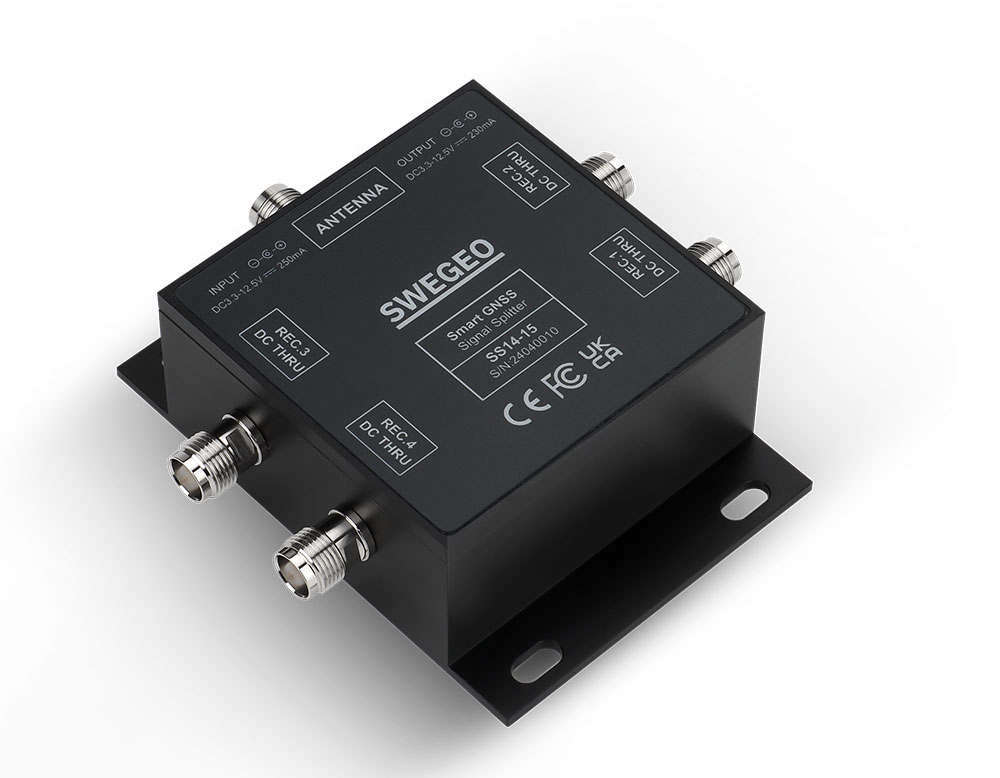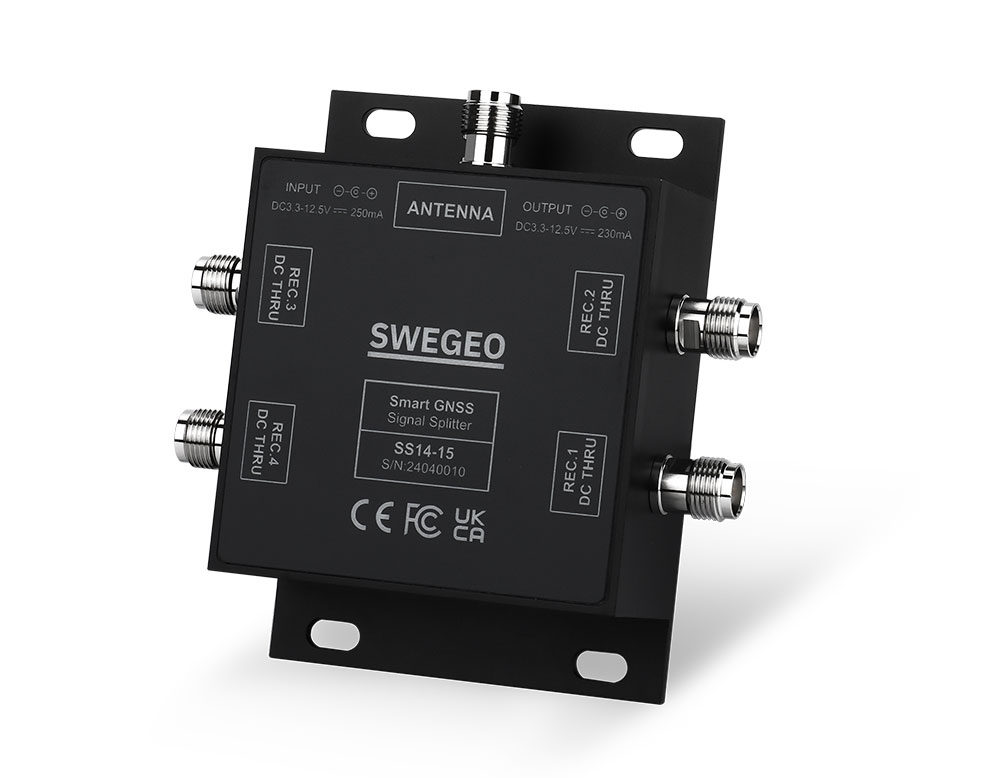

Swegeo SS14-00
Active GNSS Splitter with 4 Ports
Key Feature
- The Swegeo SS14-00 is a professional-grade full GNSS band signal splitter designed to connect one antenna to up to four receivers. Its symmetrical technical design ensures the delay consistency of each channel, providing reliable performance across various applications. The SS14A supports a wide range of signals, including GPS/QZSS-L1/L2/L5, QZSS-L6, GLONASS-G1/G2/G3, BeiDou-B1/B2/B2a/B3, Galileo-E1/E5a/E5b/E6, and L-band correction services. With its robust and durable construction, this splitter is ideal for high-precision GNSS operations in demanding environments.
Accepts Power from All Attached Receivers
Allows seamless power integration by accepting power from any of the connected GNSS receivers, offering flexibility in power supply arrangements.
Supports Up to Four GNSS Receivers Sharing a Single Antenna
Enables efficient use of a single antenna for up to four GNSS receivers, reducing the need for multiple antennas and simplifying the setup.
Robust Construction
Built with a durable and reliable package to withstand harsh environmental conditions, ensuring long-lasting performance in various applications.
Consistent Delay for All Channels
The symmetrical design ensures consistent delay across all channels, providing reliable and accurate signal distribution for all connected receivers.
Survey & Test Labs:
Survey & Test Labs: The SS14-00 splitter enables one GNSS antenna to feed up to four receivers, which is very useful in a lab or testing environment. For instance, a survey equipment manufacturer’s lab can connect a single rooftop antenna to multiple receiver prototypes at once. Each receiver under test gets the same live sky signal, allowing engineers to compare performance or calibrate devices uniformly. Because the SS14-00 ensures equal signal delay and passively splits with minimal loss, all connected receivers maintain high signal quality. This setup is also common in certification labs where they might need to verify several GNSS devices simultaneously under identical conditions (e.g., testing how different models handle a simulated satellite outage or interference while fed from the same antenna source).
Vehicle and Fleet Installations:
In some specialized vehicle installations, multiple GNSS-based systems need input from a single antenna. The SS14-00 can be installed in a utility vehicle, for example, to split the signal from one roof-mounted antenna into a tracking unit, a navigation tablet, and a timing module. Each system can operate without needing its own antenna, reducing clutter and ensuring they all reference the exact same satellite signals. This is particularly useful for emergency or military vehicles where space for antennas is limited but various GNSS-enabled equipment (like navigation, communication, and telemetry systems) must run together. The splitter’s ability to accept power from any connected receiver also simplifies wiring – whichever device provides antenna power will automatically feed the roof antenna’s LNA through the SS14-00.
Permanent Reference Stations:
Some continuous operating reference stations (CORS) or timing installations use splitters to provide redundancy. Using the SS14-00, an organization could have one high-grade antenna on the roof and split its signal to two or three receivers: one might be the primary surveying reference receiver, another a backup receiver, and perhaps a third a time synchronization unit for a network. This way, if one receiver goes down, another is already live on the same antenna feed. The passive design of SS14-00 means even if power is lost on one port, the others aren’t affected – a critical feature for ensuring continuous operation in 24/7 infrastructure setups.
| Feature | Specification | Feature | Specification |
|---|---|---|---|
| Nominal Impedance | 50 Ω | Frequency Range | 1154 ~ 1621 MHz |
| Gain | 0 dB | VSWR | ≤1.5:1 typ., 1.8:1 max |
| Phase Balance | 2.0° (Typ.), 5.0° Max | Amplitude Balance | ±0.5 dB |
| Maximum RF Input (Antenna) | 10 dBm | Input 1 dB Gain Compression Point | ≥ -10 dBm |
| Dimensions | 105 × 75 × 37 mm | Weight | 250 g |
| Connector | 6 × TNC (Female) | Base Material | Aluminum alloy 6061-T6 |
| Attachment | Four screw holes | Antenna Through Current | ≤250 mA |
| Splitter Operation Current | ≤45 mA | Noise Figure* | ≤2.0 dB @25°C Typ. |
| DC Input | On any port: 3.3 ~ 12.5 V DC | Ingress Rating | IP67 |
| Operating Temperature | -40°C to +85°C | Storage Temperature | -45°C to +85°C |
| Humidity | 95% Non-condensing |


Swegeo SS14-00
Active GNSS Splitter with 4 Ports and 15 dB Gain
Key Feature
- The Swegeo SS14-00 is a professional-grade full GNSS band signal splitter designed to connect one antenna to up to four receivers. Its symmetrical technical design ensures the delay consistency of each channel, providing reliable performance across various applications. The SS14A supports a wide range of signals, including GPS/QZSS-L1/L2/L5, QZSS-L6, GLONASS-G1/G2/G3, BeiDou-B1/B2/B2a/B3, Galileo-E1/E5a/E5b/E6, and L-band correction services. With its robust and durable construction, this splitter is ideal for high-precision GNSS operations in demanding environments.
OVERVIEW
Accepts Power from All Attached Receivers
Allows seamless power integration by accepting power from any of the connected GNSS receivers, offering flexibility in power supply arrangements.
Supports Up to Four GNSS Receivers Sharing a Single Antenna
Enables efficient use of a single antenna for up to four GNSS receivers, reducing the need for multiple antennas and simplifying the setup.
Robust Construction
Built with a durable and reliable package to withstand harsh environmental conditions, ensuring long-lasting performance in various applications.
Consistent Delay for All Channels
The symmetrical design ensures consistent delay across all channels, providing reliable and accurate signal distribution for all connected receivers.
USE CASES
Survey & Test Labs:
Survey & Test Labs: The SS14-00 splitter enables one GNSS antenna to feed up to four receivers, which is very useful in a lab or testing environment. For instance, a survey equipment manufacturer’s lab can connect a single rooftop antenna to multiple receiver prototypes at once. Each receiver under test gets the same live sky signal, allowing engineers to compare performance or calibrate devices uniformly. Because the SS14-00 ensures equal signal delay and passively splits with minimal loss, all connected receivers maintain high signal quality. This setup is also common in certification labs where they might need to verify several GNSS devices simultaneously under identical conditions (e.g., testing how different models handle a simulated satellite outage or interference while fed from the same antenna source).
Vehicle and Fleet Installations:
In some specialized vehicle installations, multiple GNSS-based systems need input from a single antenna. The SS14-00 can be installed in a utility vehicle, for example, to split the signal from one roof-mounted antenna into a tracking unit, a navigation tablet, and a timing module. Each system can operate without needing its own antenna, reducing clutter and ensuring they all reference the exact same satellite signals. This is particularly useful for emergency or military vehicles where space for antennas is limited but various GNSS-enabled equipment (like navigation, communication, and telemetry systems) must run together. The splitter’s ability to accept power from any connected receiver also simplifies wiring – whichever device provides antenna power will automatically feed the roof antenna’s LNA through the SS14-00.
Permanent Reference Stations:
Some continuous operating reference stations (CORS) or timing installations use splitters to provide redundancy. Using the SS14-00, an organization could have one high-grade antenna on the roof and split its signal to two or three receivers: one might be the primary surveying reference receiver, another a backup receiver, and perhaps a third a time synchronization unit for a network. This way, if one receiver goes down, another is already live on the same antenna feed. The passive design of SS14-00 means even if power is lost on one port, the others aren’t affected – a critical feature for ensuring continuous operation in 24/7 infrastructure setups.
APPLICATIONS


TECHNICAL SPECIFICATIONS
| Feature | Specification | Feature | Specification |
|---|---|---|---|
| Nominal Impedance | 50 Ω | Frequency Range | 1154 ~ 1621 MHz |
| Gain | 0 dB | VSWR | ≤1.5:1 typ., 1.8:1 max |
| Phase Balance | 2.0° (Typ.), 5.0° Max | Amplitude Balance | ±0.5 dB |
| Maximum RF Input (Antenna) | 10 dBm | Input 1 dB Gain Compression Point | ≥ -10 dBm |
| Dimensions | 105 × 75 × 37 mm | Weight | 250 g |
| Connector | 6 × TNC (Female) | Base Material | Aluminum alloy 6061-T6 |
| Attachment | Four screw holes | Antenna Through Current | ≤250 mA |
| Splitter Operation Current | ≤45 mA | Noise Figure* | ≤2.0 dB @25°C Typ. |
| DC Input | On any port: 3.3 ~ 12.5 V DC | Ingress Rating | IP67 |
| Operating Temperature | -40°C to +85°C | Storage Temperature | -45°C to +85°C |
| Humidity | 95% Non-condensing |


